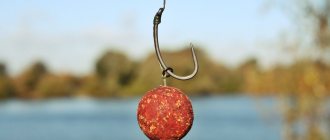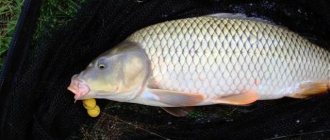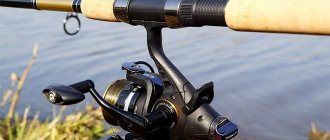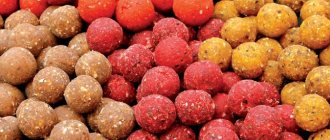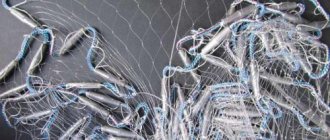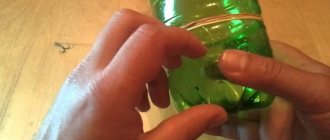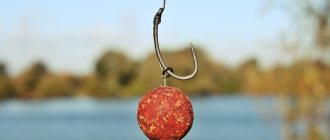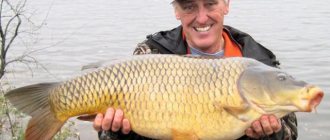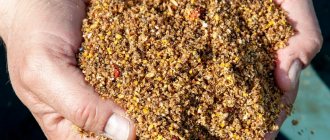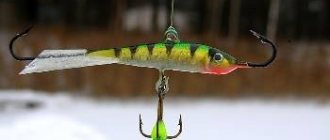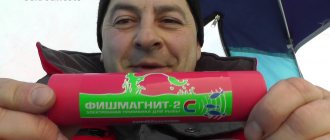The success of a good catch depends on properly selected fishing gear and prepared bait. Boilies for carp are the most effective and best baits for catching this type of fish.
At the same time, homemade boilies significantly increase the chance of getting a solid catch, since when you prepare them yourself, you can combine various components and thereby select the optimal composition of the bait.
The right boilies for carp fishing
To properly prepare boilies, you need to take into account the characteristics of carp fishing. This type of fish responds very well to food signals, which are represented by a combination of several aromas. Taste organs are located throughout the body of the fish.
Therefore, the correct bait or bait boilie for carp must contain the correct combination and proportions of attractive substances in the bait, which mainly consist of water-soluble components of various chemical natures.
The bait should emit an aroma that is attractive to the fish, and the bait and bait boilies should work as a single system. That is, the composition of bait and bait boilies should be identical.
The color of the boilies is no less important. Two-color boilies are more effective. Boilies should be tasty, but not very nutritious. When choosing branded boilies in stores, you need to pay attention to their expiration date. Fresh boilies should have a softer consistency.
How to catch carp with boilies
The technique of bottom fishing with boilies is based on the self-hooking of the carp by sucking in the bait with an exposed hook. Self-cutting occurs due to a heavy feeder or a classic blind weight. The tackle is placed on the signaling device, placed at the fish feeding point, and they wait for a bite, after which they immediately begin fishing.
The bite of the carp is sharp; after taking the bait, the fish quickly moves away to the place of shelter, which, given the slowness of the fisherman, guarantees a dead hook. The carp's resistance is impressive due to its aggressiveness.
Important! When fishing, the cord must be kept taut at all times, otherwise the fish will wind the thread around itself and cut it with a sharp file located on the front ray of the dorsal fin.
It is more correct to pump out the trophy by raising and lowering the rod, while simultaneously reeling in the freed cord with a reel. Having pulled the caught fish to the shore to lift it, be sure to use a wide landing net, because even when dragged to the shore, a carp fights for its life to the last, dodging and freeing itself from the hands of the fisherman holding it with powerful throws.
DIY boilies for carp
According to most fishermen, fishing with boilies increases the chance of getting a good catch when fishing for large carp several times. This type of bait is ideal for catching large carp, as well as for feeding and attracting large schools of fish to the fishing site.
Despite the variety of ready-made baits for various types of fish, which can be purchased in specialized stores, not all boilies have the appropriate composition or smell. Often the cost of ready-made kits exceeds their effectiveness, and it is not economically profitable to use store-bought boilies for bait.
Therefore, experienced fishermen prefer to take independently prepared boilies for fishing, taking into account the characteristics of each specific reservoir.
The only thing that needs to be taken into account is that home-made boilies have a higher calorie content than branded boilies, so to attract and bait you will need less of them so that the fish do not become oversaturated.
Boilies are round balls of various diameters made from dough prepared according to special, unique recipes.
Typically, the main ingredients found in boilies include:
- soy flour;
- corn flour;
- eggs;
- semolina;
Equipment for catching carp with boilies
The equipment for catching carp with boilies is no different from the well-known and easy-to-assemble carp rigs. The most common and popular type of equipment is the paternoster. Equipment with closed feeders performs especially well when the fish are highly active. In case of passive biting, it is worth switching to equipment with method feeders or a similar method of equipping Pop-up. In these methods of assembling equipment, hooks with nozzles are introduced into bait openly served at the fishing point and are absorbed by the feeding fish.
We have already separately mentioned the use of equipment with a PVA package in one of the sections of our article. In all presented types of equipment, hair installation is used, which we will dwell on in more detail, since this is considered the most rational and practical way to introduce a boilie into any equipment.
Hair installation - a method of attaching a boilie to a hook

The essence of hair mounting is that when installing the bait, the hook remains completely open, and the boilie hangs on a short piece of fishing line just below it. When the bait is sucked in, the fish automatically swallows the hook located nearby. It’s not difficult to learn how to attach a boilie to a hair rig yourself; the main thing is to figure out how to properly knit a hook in such a way that there remains a free tip of the fishing line located parallel to its fore-end. After this, all that remains is to make a through hole in the ball, thread a hair into it and secure the bait on the fishing line with a stopper inserted into the loop of the hair.
Boilie preparation technology
In addition to the main ingredients, the following are added to homemade boilies: milk powder, bird food, salt, betaine hydrochloride, glucose, vitamin supplements, salt, ground sunflower or hemp kernels, various flavorings, dyes.
Sequence of boilie preparation:
- The preparation of this type of bait for carp has a universal technology and requires adherence to a strict sequence:
- In a plastic, ceramic or glass container, you need to mix together all the dry components of the dough bait , consisting of different types of cereals, mixing them well. Another vessel is intended for preparing a cocktail from liquid ingredients.
- At the next stage, the dry and liquid ingredients are combined in one container , and in order to obtain the most homogeneous consistency, it is necessary to gradually add the liquid fraction to the dry, actively mixing the resulting substance. It is very important to mix all the components of the future bait well so that the dough acquires the necessary elasticity, uniformity, and does not have lumps. Properly prepared dough should not be too liquid, sticky, or viscous.
- After the dough is well mixed, it is necessary to separate small pieces from the main mass and roll them into a long sausage on a flat surface , the thickness of which depends on the size of the future carp bait. The approximate thickness should not be less than 1 cm.
- Then the strong, well-rolled sausages are divided into separate fragments , small cubes, from which they are rolled into balls.
- The balls can be heat treated in an oven, microwave, container, or boiling water. The duration of boiling the balls in water should not exceed two to three minutes.
- After heat treatment, the finished balls must be laid out on a flat surface on a cotton, clean towel or cloth so that they do not come into contact with each other and dried for 12-24 hours. Boilies should be dried in a well-ventilated, ventilated area with a minimum level of humidity. Avoid exposure to sunlight, which will cause the bait to lose its properties.
Heat treatment largely affects the properties of boilies. So, if the balls were first boiled and after drying they were frozen, you can get dense, sinking baits that are suitable for carp fishing during the period when large schools of fish gather at the bottom, in the pits of reservoirs. A bait that has undergone such treatment does not soak in water for a long period of time.
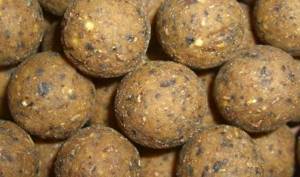
If a microwave is used for heat treatment of boilies, the bait will have a porous, light structure. Such boilies are buoyant, but when left in the water for a long time they quickly become wet, so from time to time you need to check the hook and re-attach the bait to it.
Soft boilies are best used for reservoirs with a lot of activity and a lot of fish.
Preparing the bait is quite simple, but you can add other ingredients to the classic recipe that will give a special taste to the boilies. Carp is an omnivorous and voracious fish, but due to the presence of sensitive organs, the fish is able to evaluate some components in food items that are just beginning to dissolve in water.
To ensure that the boilies have buoyancy and do not quickly get wet in the water, you can place foam balls or a plastic plug inside, which act as ballast.
Ready-made boilies can be stored in the refrigerator, in a hermetically sealed container or bag, so that the bait does not absorb foreign odors that may scare away the fish. You can store the bait in the freezer in plastic bags, after adding the same flavor that was used in the preparation process.
To prepare boilies yourself, you can purchase special equipment: a table for rolling out sausages and rolling out boilies, a syringe. Additional equipment will simplify the process of preparing a large amount of bait and will allow you to get bait of the same shape and diameter.
Stages of preparing floating boilies

- Dry and liquid ingredients are mixed together.
- After this, knead the dough until smooth.
- The entire batch is divided into several parts.
- And sausages are formed from each part, after which they are cut into small pieces.
- Small pieces are formed into balls and placed on a tray.
After this, boilies are made from the resulting balls. If you boil them and then dry them, you get sinking baits. To obtain floating baits, you can use several methods. The simplest option is to bake them in the microwave. In this case, the maximum power is selected. Boilies are considered ready if they have already begun to burn, but they should not be allowed to reach this state. You can check how buoyant the boilies are in a glass of water. With the help of such experiments, you can select and determine the size of the boilies. After this, hooks are selected for such boilies. It is very important that the hook does not pull the boilie to the bottom, and that the bait with the hook remains in the water column.
There is another option. To ensure the buoyancy of boilies, you can use cork material:

- To do this, you need to grind the cork and add it to the main mixture. Such boilies are not baked in the microwave, but boiled.
- Use pieces of cork. To do this, they are coated with dough and boiled.
- You can make a sinking boilie float if you drill a hole in it and insert a piece of cork into it. Unfortunately, this process is quite labor-intensive.
If you make boilies based on cork, then their diameter should not be more than 15 mm, since cork is too buoyant. Although, the buoyancy of boilies can be adjusted by the size of the pieces of cork, and after lengthy trials you can decide on this issue.
Secret ingredients of boilie for carp
In addition to the main ingredients - cereals, eggs, flour, in order for the fish to become interested and swallow the bait, when preparing boilies yourself, you need to use some secrets that will increase the taste and nutritional properties of the bait.
Namely, use “magic” additives - flavors, liquid and dry dyes, attractants. The concentration of certain ingredients and the composition of the boilies are determined by the time of year, the temperature of the water, the type and specifics of the reservoir.
Dyes
The color of the bait is of great importance when fishing, especially in winter. At this time of year, carp have weakened olfactory functions and, in search of prey, the fish orient themselves using their vision. The most attractive colors for fish are yellow, white, purple, and red. Although the opinions of experienced fishermen constantly differ on this issue.
The main thing is not to use dark-colored boilies in ponds with muddy water. Fans of night fishing can use boilies coated with fluorescent dyes. When choosing a dye for bait, you need to take into account the characteristics of the reservoir, and it would be nice to know the preferences of the carp that live in a particular reservoir.
Flavors
To prepare boilies, you can use regular food flavorings, culinary spices, seasonings, or special ones that can be purchased at fishing stores. If homemade boilies contain fishmeal, flavorings may not be used. Conventionally, flavorings can be classified into: liquid and dry.
Liquid flavors
The group of liquid flavors includes: jelly-like dips (blended sauce for dipping ready-made balls at the fishing spot), extracts of various plants, fruit syrups, liquid dips. Some flavor enhancers are added during the cooking stage, others are used after the bait is fully cooked, before placing the balls in boiling water.
Liquid flavors provide a long-lasting flavor and are added in minimal quantities. For 1 kg of dry matter – 3-7 ml of substance.
Dry spices and herbs
Dry aromatic substances include dry spices, various types of spices, and powdered dips. Homemade boilies can be given a unique aroma by anise seeds, dill, curry seasoning, ground cinnamon, and red pepper. Dry herbs and spices are introduced into a container for dry bait ingredients.
It is worth considering that an excess of aromatic components can ruin boilies. The recommended dosage is 1 ml of substance per 100 g of dry mixture.
Substances that improve digestion
To increase the fish’s interest in baits and activate digestive reflexes, special enzymes and food additives are added to boilies.
These include:
- Ground hemp, sunflower, fennel seeds.
- Flaxseed pulp.
- Betaine HCI.
- Flour from gammarus, daphnia, bloodworms, squid.
- Birdseed.
- Sprouted wheat flour.
Table salt, sea salt. The salt must first be ground in a coffee grinder. This component gives the boilies a porous structure, is a natural preservative, increases the diffusion of water into the bait, accelerating the dissolution of the components.
Ingredients for floating boilies

Regardless of what kind of boilies they are - sinking, neutral or floating, their composition is almost identical. They differ from each other only in the technology of preparing the dough: sinking boilies are boiled, and floating boilies are cooked in the microwave. At the same time, the composition of boilies can be very diverse. The dough contains dry ingredients, binders and aromatic ingredients. All this taken together is mixed with eggs or water.
Boilies can contain both nutritious and low-calorie ingredients. It all depends on the fishing conditions. If you need to attract fish for a short time, you can use low-calorie boilies with a pronounced aroma; if you need to attract fish for a long period, then high-calorie boilies are used along with bait.
Animal Ingredients:
- meat products;
- chopped fish;
- chopped bones and meat;
- casein and milk.
Herbal Ingredients:
- various flours;
- various cereals;
- birdseed.
The color and aroma of boilies are of great importance, so various flavors and dyes should be added to the main composition.
Flavorings can be:
- chocolate;
- various oils;
- sunflower seeds (crushed);
- curry;
- caraway;
- cinnamon;
- garlic.
If meat or bird food is added to the mixture, then flavorings can be dispensed with, but if the composition contains fresh elements, such as flour, cereals, then flavorings are necessary.
The color of the boilies should be contrasting with the underwater world. Bright shades such as red, yellow, orange, etc. are more suitable.
Boilie recipes for carp fishing
Despite the universal technology for preparing boilies for carp fishing, each fisherman uses his own secrets for cooking, so here are the most popular recipes that you can very easily prepare yourself.
A universal recipe for preparing a boilie for carp fishing:
- Corn flour - 1 cup.
- Soy flour – 1 cup.
- Semolina – 600 g.
- Powdered milk – 300 g.
- Eggs – 8-10 pieces.
- Sunflower kernels – 1 cup. You can take half a glass of sunflower and hemp seeds.
- Sunflower oil – 2 tbsp. l.
- Food coloring – 1 tsp.
- Flavoring – 5-7 mg or “to taste”.
Mix all dry ingredients. Peel and grind the seeds in a coffee grinder, add to the dry mass. Beat the eggs well with a whisk and add sunflower oil. Gradually add the dry part to the liquid mass, stirring the mixture constantly.
The dry part is added until the mixture reaches the desired consistency (thickness). Knead the dough well, cover with a plastic bag and wait 20-30 minutes for the flour to release the gluten. Then, separating small fragments, form the dough into sausages, cut into squares and roll into balls of the desired diameter.
Boil the dough balls in boiled water, dry them and put them in an airtight bag.
Recipe No. 2:
- Corn flour – 250 g.
- Semolina – 250-300 g.
- Table salt – 50 g.
- Crushed, fried sunflower kernels – 30 g.
- Hemp seeds – 30 g.
- Chocolate flavoring – 2 tsp.
- Betaine – 15 mg.
Recipe No. 3:
- Bird food, fish, corn, wheat flour in proportions 1:1:1:2.
- Eggs – 9-10 pieces.
- Fish oil – 20 ml.
- "Maggie" - 25 ml.
- Soy vinegar – 15 ml.
- Sweetener – 2 ml.
Liver boilie
“Liver” is a fairly common and effective bait for catching carp.
For preparation you will need the following ingredients:
- Semolina – 1 glass.
- Raw liver – 150 gr.
- Soy flour – 50 gr.
- Dry garlic - a teaspoon.
- Eggs – 5-6 pcs.
- Honey – 3 teaspoons.
Grind the liver in a blender, beat the eggs in a separate bowl, add honey, garlic powder, mix well. In the second container, mix the dry ingredients, gradually add the liquid part to them until the dough of the desired thickness is obtained.
If necessary, you can add a little semolina or flour. Knead the dough well, form into sausages, cut into balls. When the water boils, place it in boiling water for two to four minutes.
As soon as the boilies float to the surface of the water, remove them with a slotted spoon, cool slightly and lay them out on a flat surface until they cool completely. Dry for at least six to eight hours.
Recipe for catching carp in summer:
- Soy flour – 300 g.
- Corn flour – 400 g.
- Semolina – 150 g.
- Hemp seeds – 50 g.
- Fried sunflower kernels – 50 g.
- Salt – 50 g.
- Any fruit flavor.
DIY boilies for carp
Dusting or soluble boilies are a special type of bait, the composition of which allows you to maximally preserve all the properties of the ingredients included in the product. Dusty boilies, unlike regular boilies, do not absorb water.
As the surface slowly erodes, thanks to varying degrees of buoyancy of the components, some of which sink, others float in the water column, and others float, the boilie begins to “gather dust,” effectively attracting the attention of fish.
In addition, particles of the product enter the water, which stimulate the fish’s receptors, increasing appetite. If you prepare this type of bait correctly, boilies will dissolve for several hours even in warm water.
Taking into account this feature, it is necessary to systematically throw boilies to attract fish into the fishing zone. Dusty boilies are an excellent alternative to bait balls.
The main difference between dusty boilies and boiled boilies is the cooking technology. Instant boilies are not subjected to any heat treatment at all. The dough balls are simply dried. This feature allows you to preserve the nutritional and taste properties of the bait as much as possible.
When gradually dissolved in water, boilies will release vitamins, aromatic particles and other components attractive to fish into the water. In order for dusty boilies to ensure their function, the dough is kneaded not with eggs, but with syrup, molasses, and honey.
Instant boilie recipe:
- Roasted, crushed flax and hemp seeds – 35 g.
- Buckwheat – 50 g.
- Corn flour – 35 g.
- Semolina – 20-25 g.
- Corn syrup (corn, invert sugar syrup) – 50-60 g.
You can also use sweet beet molasses. Sweet syrup is also a sweetener, improves the taste, and ensures gradual dissolution of the bait in the water.
The process of preparing dust boilies is practically no different from preparing universal, boiled balls for carp fishing. Simply use corn syrup or sweet syrup instead of beaten eggs. Too thick syrup can be diluted slightly with warm filtered water.
The dry part is gradually introduced into the syrup, constantly stirring the mixture until a homogeneous mass of normal thickness is obtained. You need to knead the dough very well and after kneading, place it in a plastic bag, put it in the refrigerator for at least an hour, and it is best to leave the dough in the refrigerator for 10-12 hours.
After the dough has been in the refrigerator, it should have the consistency of elastic plasticine. When rolling further, the dough should not stick to the board or to your hands. First, roll out the sausages to the required thickness, cut into squares, form into balls and lay them out on a flat surface to dry for 6-8 hours.
Making boilies at home

Any fisherman can make his own boilies for carp hunting. Many recipes have been developed for preparing catchable bait for this representative of the ichthyofauna. They differ in components and purpose. According to the time of year they are for:
- cold water (late autumn, early spring);
- warm water (summer, late spring, early autumn).
Recommended reading: About bait for fish
Based on buoyancy, boilies can be made:
- drowning;
- floating.
It is difficult to obtain a neutrally buoyant bait at home. If you want to fish with such bait, you will have to buy it at a fishing store.
Separately, we note dusty boilies, during the preparation of which components are added to the dough that quickly decompose in water. The bait, sinking to the bottom and lying on the ground, leaves behind a noticeable trail of turbidity, attracting the attention of the fish.
Semolina boilies
All carp fish love semolina, so baits based on this ingredient are considered one of the best. Moreover, it is very simple to prepare it. For this we need cereal, water, dyes and flavors. The recipe is as follows:
- We take semolina and water in a 1:1 ratio.
- Place a pan of water on the fire and wait until it boils.
- Pour porridge, dyes and flavors into boiling water.
- Reduce heat and cook until the water has completely evaporated.
- At the very end, you need to stir the porridge with a spoon so that there are no lumps left in it.
- Now turn off the heat, let the porridge cool and begin to form balls of the desired size from it.
- While they are still wet, we string them on a thread and send them to dry.
That's it, homemade semolina boilies are ready. They can be hooked onto a hair rig using a thread and thrown into the water.
Corn boilies
Baits made with corn grits or flour work best in the summer, when carp prefer plant components and sweet tastes. For it you will need to take the following ingredients:
- corn flour;
- soy flour;
- semolina;
- casein or egg;
- sunflower and hemp seeds;
- salt;
- fruit flavoring.
Pour water into a container and bring it to a boil. Pour 400 and 200 grams of corn and soy flour into a pan, respectively, 150 grams of semolina and casein. Instead of the latter, you can take the protein from 3-4 chicken eggs. We grind 50 grams of hemp and sunflower seeds, which we add to our mixture along with salt and fruit flavoring at the end of cooking.
We recommend reading: Bait for bream in winter
Boilies from makuha
Carp are excellently caught using cake baits. They are nutritious and emit a pleasant aroma that attracts fish from a long distance. To prepare you will need:
- 1 kg of flour;
- 300 grams of dried egg white (albumin);
- 100 grams of wheat gluten;
- 50–70 grams of sugar or powder.
Mix all the ingredients thoroughly and let the dough sit for about an hour. Then we roll it into sausages and cut into cylinders 5–15 mm long. All that remains is to cook and dry the boilies.
Dusting boilies
This type differs from classic boiled baits in that no heat treatment is used in their preparation. The fisherman kneads the dough, forms it into balls of the required size, and dries them in the open air.
Note! Dusting baits work at any time of the year.
A homemade dusty boilie can be made from a mixture of semolina and buckwheat, corn flour and molasses, crushed into a fine fraction of hemp and sunflower seeds according to the following recipe:
- Mix the dry ingredients in a container, distributing them evenly among themselves.
- Gradually add molasses or syrup to the mixture.
- Stir, adding syrup, until we get a homogeneous thick mass.
- Wrap the resulting dough in a plastic bag and place it in the refrigerator for 10–12 hours.
The result should be a dough resembling plasticine that will not stick to your hands or cutting board. Roll it into a cylinder and cut into segments 5–10 mm long. All that remains is to dry the nozzle at room temperature for 6–8 hours.
Floating and sinking boilies
Most boilies are boiled in a pan of water, then dried in the oven or in the open air. The result is sinking baits with a dense consistency. It holds well in the rig, does not get wet for a long time, and therefore does not require frequent re-casting of the rig.
Floating boilies differ from sinking boilies in that they are not boiled down. Balls of the required diameter are formed from the kneaded dough, and then the moisture is evaporated from them using a microwave oven. The resulting nozzle has positive buoyancy, but quickly gets wet, falling apart into pieces.
Blitz tips
The process of preparing boilies for successful carp fishing is quite simple.
Initially, you need to decide on the basic composition of the bait, determine the quantity, concentration of components and additives:
- The boilie should be attractive and tasty to the fish, but not too nutritious.
- If boilies are prepared using bone or meat meal, flavoring may not be added.
- You can increase the attractiveness of the bait by adding 10-20g of fish oil.
- You can enhance and make the color more saturated using dry baits.
- To make balanced boilies, it is necessary that the bait composition consists of 40% floating and 60% sinking mixture.
- You can change the shape of boilies and form not only balls, but also triangles, rhombuses, and squares.
When choosing a recipe for boilies, you need to take into account the characteristics of the reservoir, the time of year, and the size of the fish. Fishing for carp has its own characteristics, which should also not be forgotten when preparing bait for successful fishing.
PVA bags and their use

PVA bags are prefabricated bait supplied to the fishing zone using a certain technology. Boilie bait, which includes a hook, and bait are introduced into a bag that dissolves in water. The set is delivered to the fishing point with a pre-created feeding spot. Dissolving in water, the package creates a food spot with a more intense concentration in a predetermined place, additionally attracting fish, where it sucks in the main, large-sized bait.
The bags can be floating or sinking, but in carp fishing they use a version of the device that goes down to the bottom. Sometimes in retail outlets this set of nozzles is offered to the buyer under the abbreviation PVA sticks.

